Doukhobor
Dugout House re-enacts 1895 burning of guns
June
27 event reported in 3 Saskachewan newspapers- 1922 June 29 — 87 years ago, Verigin
Saskatchewan
- 2009 June 14 — Saskatoon Sun, Part 1, page 9.
- 2009 June 19 — Battlefords Regional Optimist, page 41.
- 2009 June 19 — Shellbrook Chronicle, page 15.
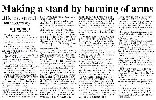
Saskatoon Sun
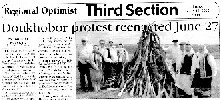
Battlefords Regional Optimist
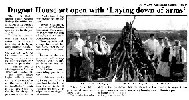
Shellbrook Chronicle
87 years ago
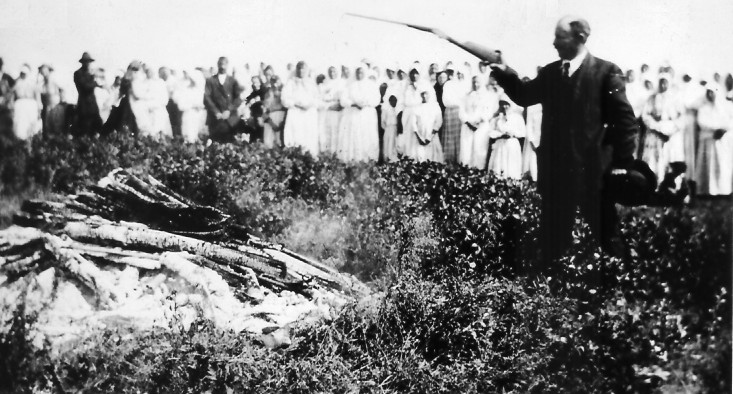
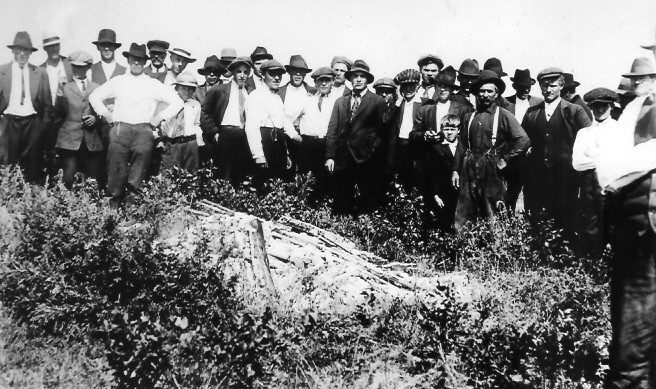
A symbolic re-enactment of the burning of arms and a reminder that the way of non-violence is the way to wold peace and understanting. Verigin, Saskachewan — June 29, 1922. (First photo from Koozma J. Tarasoff, Pictorial History of the Doukhobors, 1969: 143).
 Part 1, page 9 — June
14, 2009
Part 1, page 9 — June
14, 2009 Making a stand by burning of arms
Heritage site retells Doukhobor story
By Darlene Polachic,
for The Saskatoon Sun
for The Saskatoon Sun
Doukhobor men living in Russia in the late 1800s were not exempt from service in the Czar's army even though they were pacifists by conscience and religious persuasion.
"Doukhobors believe the Spirit of God lives within each person," Bill Kalmakoff says, "and to kill another human being is to kill the Spirit of God."
As a show of opposition, on Easter Sunday in 1895, 11 Doukhobor men, led by Harvey Lebedev, at Elizavetpol made the decision hey would not kill anymore, and simply laid down their arms. Other soldiers followed suit, and endured beatings, whippings, imprisonment and, in some cases, exile.
At midnight on June 28 of that same year, during the Russian religious celebration of he Feast of St. Peter and St. Paul, Doukhobors in three different locations got together, threw their government-issued guns, knives and swords into a pile and lit them on fire, symbolically renouncing militarism and vowing they would not kill again.
This burning of arms took place at Elizavetpol, Kars and Akhalkalaki (Bogdanovka) in the Trancaucasian region of the Soviet Jnion east of the Black Sea. Seven thousand people took part in the events. Historical reports say each site burned 15 to 29 wagonloads of weapons.
"The Doukhobor people had positioned themselves in a ring around the bonfire, with the children on the inside and the men and women on the outside," says Jeanette Stringer, the spiritual leader of the Blaine Lake Doukhobor community. "The Cossack soldiers were ordered to run right over them and mow them down, but their horses refused to do it. I drink it's interesting that the horses reared up and backed off."
The consequences of the burning of arms for the Doukhobors was more beatings, persecution and exile.
"The first group started out in 1898 from Batumin on the Black Sea. They travelled on cattle ships that had been fitted with bunks and a few [c]rude stoves for cooking. The first ship arrived at Halifax in January 1899. The Doukhobors began the trek across Canada by train to Winnipeg, then on to Yorkton, where they were dispersed to three land areas the Canadian government had set aside to be Doukhobor reserves. One was in the Langham / Blaine Lake area."
Some years later, the Doukhobor communities in Canada separated, with some choosing to move on to British Columbia and the remainder staying behind to take ownership of their homelands. They became hardworking farmers whose children grew up and entered many respected occupations and professions. Kalmakoff, for instance, is a retired teacher and former regional superintendent and director of education. Peter Pereverzoff, one of the actors in an upcoming re-enactment of the burning of arms story, was a longtime pharmacist in Rosthern.
The compelling story of the Doukhobors comes to life every summer at the Doukhobor Dugout House heritage site south of Blaine Lake. Conceived and developed by Brenda Cheveldayoff on land owned by her Doukhobor forebears, the site is a popular tourist destination each summer.
This year, on Saturday, June 27, visitors to the site can experience the re-enactment of the burning of arms event.
Gates open at 9 a.m. with the dramatic telling of the tale beginning at 11 a.m.
With Brenda Cheveldayoff as narrator, the four-scene drama will relate the historical account of the original event 114 years ago. The arms for the symbolic bonfire (no actual fire will be lit) were crafted from wood by students at Blaine Lake School.
Norm Rebin, the keynote speaker for the day, will give a history presentation.
Following the re-enactment, visitors will have the opportunity to stroll through the display building, explore the historic site and enjoy music and traditional Doukhobor food. Guides in period Doukhobor costume will do various demonstrations, and Cheveldayoff will conduct a guided tour of the dugout houses at 2 p.m. (only one tour will be conducted that day).
"Because the dugout house is located in a deep ravine and some of the older folks aren't able to walk the whole tour, we have prepared a 38-mmute virtual tour that will be played in the display building so the) can share the entire experience without having t negotiate the steep path," Cheveldayoff says
"We're providing as much seating as we can for the re-enactment, but we're also asking people to bring their own lawn chairs if possible. Another important note is that we will have upgraded washroom facilities on site."
To reach the Doukhobor Dugout House site, follow Highway 12 north from Saskatoon across Petrofka Bridge to the Doukhobor Dugout House sign. Follow the gravel road east to the very end.
For more information about the historic site and the burning of arms program, visit doukhobordugouthouse.com or call 306-497-3140.
The Doukhobor Dugout House site is open Saturdays from June 27 to Aug. 8 from 10. a.m. to 5 p.m. Tours are offered at 11 a.m., 12:30, 2 and 3:30 p.m. Admission is $5 per person.
Doukhobor protest reenacted June 27
By Darlene Polachic,
Freelance writer
Freelance writer
BLAINE LAKE — Doukhobor men living in Russia in the late 1800s were not exempt from service in the Czar's army even though they were pacifists by conscience and religious persuasion.
"Doukhobors believe the Spirit of God lives within each person: 'Bill Kalmakoff explains, "and to kill another human being is to kill the Spirit of God."
As a show of opposition, on Easter Sunday of 1895, 11 Doukhobor men at Elizavetpol led by Matvey Lebedev made the decision they would not kill anymore. They simply laid down their arms. Other soldiers followed suit, and endured beatings, whipping, imprisonment and, in some cases, exile for their actions.
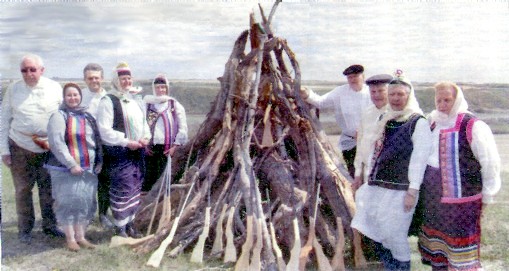
A reenactment of a Doukhobor "burning of the arms" protest will be staged at the Doukhobor Dugout House heritage site south of Blaine Lake June 27. Click here for big image.
In the photo are: Peter Pereverzolf, Dan Cheveldayoff, Patty Serwotki (nee Popoff), Jeanette Stringer, Brenda Cheveldayoff, Wally Dargin, Bill Kalmakoff, Donna Choppe and Edna Wright. Photo by Darlene Polochic
Jeanette Stringer, the spiritual leader of the Blaine Lake of the Doukhobor community, adds, the Doukhobor people had positioned themselves in a ring around the bonfire, with the children on the inside and the men and women on the outside. The Cossack soldiers were ordered to run fight over them and mow them down, but their horses refused to do it. I think it's interesting that the horses reared up and backed off."
The consequences of the Burning of Arms for the Doukhobors were more beatings, persecution, and exile.
"With help from novelist Leo Tolstoy and Quakers in North American, and the encouragement of Queen Victoria's government, arrangements were made for large groups of Doukhobor people to leave Russia and immigrate to Canada," Bill Kalmakoff goes on. "The first group started out in 1898 from Batumin on the Black Sea. They traveled on cattle ships that had been fitted with bunks and a few rude stoves for cooking. The first ship arrived at Halifax in January of 1899. The Doukhobors began the trek across Canada by train to Winnipeg, then on to Yorkton where they were dispersed to three land areas the Canadian government had set aside to be Doukhobor reserves. One was in the Langham / Blaine Lake area."
The compelling story of the Doukhobors comes to life every summer at the Doukhobor Dugout House heritage site south of Blaine Lake. Conceived and developed by Brenda Cheveldayoff on land owned, by her Doukhobor forebears, the site is a popular tourist destination each summer.
Saturday, June 27, visitors to the site can experience the re-enactment of the Burning of Arms event.
Gates open at 9 a.m. with the telling of the story beginning at 11 a.m.
With Brenda Cheveldayoff as narrator, the drama will relate the historical account of the original event 114 years ago.
The 'arms' for the symbolic bonfire (no actual fire will be lit) were crafted from wood by students at Blaine Lake Composite School.
The program also includes readings and greetings from officials including representatives from government and Saskatoon Mayor Don Atchison. Members from the Mennonite Church and Quakers, both of whom share the Doukhobors' pacifist beliefs, have been invited. Another guest will be J.J. Verigin Jr., the son of the late J.J. Verigin, Sr., who was the chair of Union of Spiritual Communities of Christ.
Following the reenactment, visitors have opportunity to stroll through the display building, explore the historic site, and enjoy music and traditional Doukhobor food. Guides in period Doukhobor costume will do various demonstrations, and Cheveldayoff will conduct a guided tour of the dugout houses at 2 p.m.
"Because the dugout house is located in a deep ravine and some of the older folks aren't able to walk the whole tour, we have prepared a 38-minute virtual tour that will be played in the display building so they can share the entire experience without having to negotiate the steep path.
Cheveldayoff adds, "We're providing as much seating as we can for the re-enactment, but we're also asking people to bring their own lawn chairs, if possible. Another important note is that we will have upgraded washroom facilities on site."
To reach the Doukhobor Dugout House site, follow Highway 12 north from Saskatoon across Petrovka Bridge to the 'Doukhobor Dugout House' sign. Follow the gravel road east to the very end.
 Page 15 — Friday June 19, 2009
Page 15 — Friday June 19, 2009
Dugout House set [to] open with 'Laying down of arms'
Doukhobor descendents from across the region will be taking part in a play of the laying down of arms at the site.
Site owner, Brenda Cheveldayoff describes the reenactment as the burning of arms plus since the group has added three scenes to the production.
"It tells the story of What happened in Russia in 1895," said Cheveldayoff.
The play, which begins with a narrative by Cheveldayoff to set the scene, follows the Doukhobor's plight as they leave Russia for Canada, the change of government that lead to the Dotobors losing their land, and the sale itself.
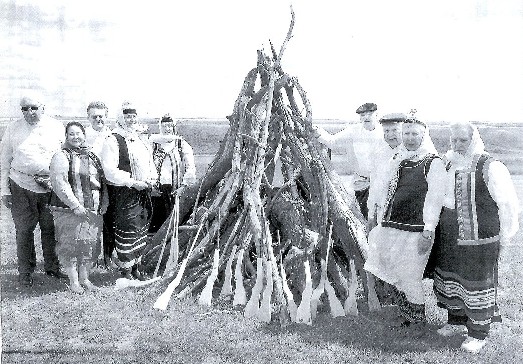
A demonstration of the laying down of arms at the Doukhobor Dugout House, south of Blaine Lake. [Click on photo to enlarge.]
The group started with a script idea which has been added upon by the cast leading up to showtime.
Because of the program, there will be only one guided tour of the dugout house site that day. Tour at 2 pm.
All of the guns used for the laying down of arms were built by the Blaine Lake School Grade 10 Industrial Arts class which helped one of their logistical problems.
"They really did a good job of that," said
Cheveldayoff.
Much more information: Historic 1895
Burning of Guns Descriptions: Selections and translations
Back to Doukhobor Dugout House.org
Back to Spirit-Wrestlers.com
Back to Doukhobor Dugout House.org
Back to Spirit-Wrestlers.com